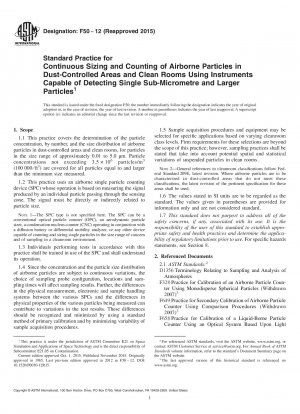ASTM F50-12(2015)
Standard Practice for Continuous Sizing and Counting of Airborne Particles in Dust-Controlled Areas and Clean Rooms Using Instruments Capable of Detecting Single Sub-Micrometre and Larger Particles
- Standard No.
- ASTM F50-12(2015)
- Release Date
- 2012
- Published By
- American Society for Testing and Materials (ASTM)
- Status
- Replace By
- ASTM F50-21
- Latest
- ASTM F50-21
- Scope
5.1 The primary purpose of this practice is to describe a procedure for collecting near real-time data on airborne particle concentration and size distribution in clean areas as indicated by single particle counting techniques. Implementation of some government and industry specifications requires acquisition of particle size and concentration data using an SPC.
5.2 The processing requirements of many products manufactured in a clean room involves environmental cleanliness levels so low that a single particle counter with capability for detecting very small particles is required to characterize clean room air. Real-time information on concentration of airborne particles in size ranges from less than 0.1 μm to 5 μm and greater can be obtained only with an SPC. Definition of particles larger than approximately 0.05 μm may be carried out with direct measurement of light scattering from individual particles; other techniques may be required for smaller particles, such as preliminary growth by condensation before particle measurement.
5.3 Particle size data are referenced to the particle system used to calibrate the SPC. Differences in detection, electronic and sample handling systems among the various SPCs may contribute to differences in particle characterization. Care must be exercised in attempting to compare data from particles that vary significantly in composition or shape from the calibration base material. Variations may also occur between instruments using similar particle sensing systems with different operating parameters. These effects should be recognized and minimized by using standard methods for SPC calibration and operation.
5.4 In applying this practice, the fundamental assumption is made that the particles in the sample passing through the SPC are representative of the particles in the entire dust-controlled area being analyzed. Care is required that good sampling procedures are used and that no artifacts are produced at any point in the sample handling and analysis process; these precautions are necessary both in verification and in operation of the SPC.
1.1 This practice covers the determination of the particle concentration, by number, and the size distribution of airborne particles in dust-controlled areas and clean rooms, for particles in the size range of approximately 0.01 to 5.0 μm. Particle concentrations not exceeding 3.58201;×8201;106 particles/m 3 (1008201;000/ft3) are covered for all particles equal to and larger than the minimum size measured.
1.2 This practice uses an airborne single particle counting device (SPC) whose operation is based on measuring the signal produced by an individual particle passing through the sensing zone. The signal must be directly or indirectly related to particle size.
Note 1: The SPC type is not specified here. The SPC can be a conventional optical particle counter (OPC), an aerodynamic particle sizer, a condensation nucleus counter (CNC) operating in conjunction with a diffusion battery or differential mobility analyzer, or any other device capable of counting and sizing single particles in the size range of concern and of sampling in a cleanroom environment.
ASTM F50-12(2015) Referenced Document
- ASTM D1356 Standard Terminology Relating to Sampling and Analysis of Atmospheres*, 2024-04-20 Update
- ASTM F328 Standard Practice for Calibration of an Airborne Particle Counter Using Monodisperse Spherical Particles
- ASTM F649 Standard Practice for Secondary Calibration of Airborne Particle Counter Using Comparison Procedures
- ASTM F658 Standard Practice for Calibration of a Liquid-Borne Particle Counter Using an Optical System Based Upon Light Extinction
- ISO 14644-1 Cleanrooms and associated controlled environments - Part 1: Classification of air cleanliness by particle concentration (includes Redline Version)
- ISO 14644-2 Cleanrooms and associated controlled environments - Part 2: Monitoring to provide evidence of cleanroom performance related to air cleanliness by particle concentration (includes Redline Version)
ASTM F50-12(2015) history
- 2021 ASTM F50-21 Standard Practice for Continuous Sizing and Counting of Airborne Particles in Dust-Controlled Areas and Clean Rooms Using Instruments Capable of Detecting Single Sub-Micrometre and Larger Particles
- 2012 ASTM F50-12(2015) Standard Practice for Continuous Sizing and Counting of Airborne Particles in Dust-Controlled Areas and Clean Rooms Using Instruments Capable of Detecting Single Sub-Micrometre and Larger Particles
- 2012 ASTM F50-12 Standard Practice for Continuous Sizing and Counting of Airborne Particles in Dust-Controlled Areas and Clean Rooms Using Instruments Capable of Detecting Single Sub-Micrometre and Larger Particles
- 2007 ASTM F50-07 Standard Practice for Continuous Sizing and Counting of Airborne Particles in Dust-Controlled Areas and Clean Rooms Using Instruments Capable of Detecting Single Sub-Micrometre and Larger Particles
- 1992 ASTM F50-92(2001)e1 Standard Practice for Continuous Sizing and Counting of Airborne Particles in Dust-Controlled Areas and Clean Rooms Using Instruments Capable of Detecting Single Sub-Micrometre and Larger Particles
- 1992 ASTM F50-92(1996) Standard Practice for Continuous Sizing and Counting of Airborne Particles in Dust-Controlled Areas and Clean Rooms Using Instruments Capable of Detecting Single Sub-Micrometre and Larger Particles

Copyright ©2024 All Rights Reserved